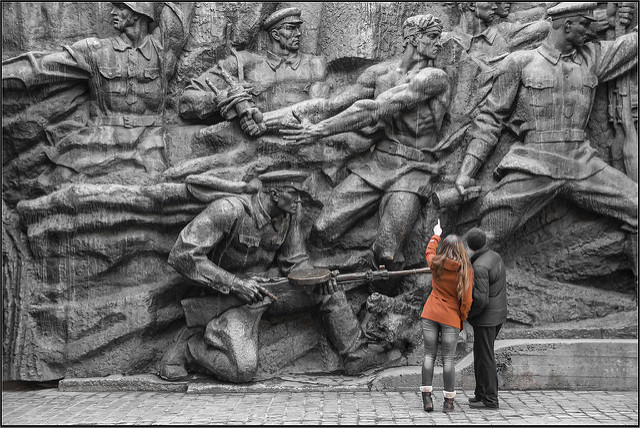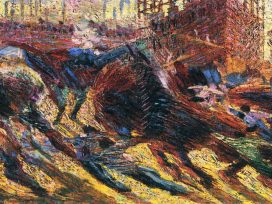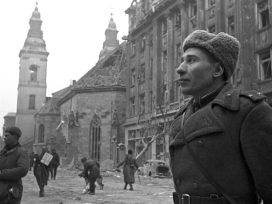Instead of dwelling upon the catastrophes of the twentieth century, many Europeans ask if we should not thoughtfully “forget” them. However, the endurance of historical memory in the united Europe is demonstrated by contemporary political differences between European member states, which can be dealt with only if a European memory is developed. The difficulty here lies in paying due respect to the memory of the crimes both of National Socialism and of Soviet totalitarianism while avoiding a hierarchy of competing victim groups.
Remembrance days and commemorative years can bring to light how different, and often how contradictory, memories in Europe are. The common construal of 8 May 1945 as “liberation day” cannot be endorsed above all by representatives of those countries where there was a seamless transition from German occupation to decades of Soviet occupation. A symbol of this were the nine “special camps” maintained by the Soviet military administration (SMAD) in eastern Germany from 1945 to 1950 at locations that previously had served the SS as concentration camps; it is stunning how two dictatorships meshed, with their defining feature, the camp system. Individual prisoners found themselves in the same camp twice, first as the opponents of National Socialism, then as “counter-revolutionary” agents or social democrats.
In such places, it is not easy to stage a commemoration that conveys the tragic double experience with the required respect without equating the two totalitarian phenomena. Therefore, the chronology of the two experiences of dictatorship must be taken into consideration as much as the fatal unity of the place. For the individual, it was a matter of indifference which system he or she fell victim to; analytically, however, the distinction remains important and must resonate in the rituals of memory. The House of Terror in Budapest, site of the torture chambers of the national socialist Arrow Cross Party occupied by the Communists after 1945, counts as a failed example of the processing of the history of the “age of extremes” (Hobsbawm). Rarely is a successful balance achieved impromptu; on the whole, a disastrous hierarchy of competing victim groups appears that does not equate “brown” and “red” dictatorships so much as set off one collective experience against another. A sinister body count is supposed to reduce the “other side” to silence.
Foregrounding the “commemoration of the Holocaust” often means, consciously or unconsciously, demoting Stalinist terror or excusing it by claiming that Communism, unlike National Socialism, pursued humane intentions and had progressive justifications. Those who mobilize the “GULag memory” often overlook, again consciously or unconsciously, that victims of Stalinism were often former collaborators with National Socialism. On the other hand, emphasizing this is likely to extenuate the post-Stalinist dictatorship up to 1990 and ignore the fact that subsequent to the Soviet Union’s pact with the German Reich parts of eastern Europe had already been occupied and “cleansed” by Russian troops before the Nazi occupation.
And so the old cui bono of the Cold War threatens to win out over truth and the political division of the continent is eternalized. For fifteen years, the post-Communist Left and the pre-Communist Right have invoked historical grievances to win elections and conduct day-to-day politics; post-Communists are found to have an incorrigible red-hot core and in return the liberal-conservative side is painted brown. Both operations serve to delegitimize respective governing elites. Alternatively, the rapid passage through two dictatorships is used to launder clean entire nations, whereby any wrongdoing is declared to be merely a side effect of uninterrupted occupation.
Speaking on the sixtieth anniversary of the liberation of the National Socialist concentration camps, the author Jorge Semprun, former member of the Communist Party of Spain and from 1943 to 1945 prisoner at Buchenwald, claimed that European enlargement could only succeed culturally and existentially “when our memories have been shared and brought together as one”. The assertion that the future of Europe depends on common memory and that the processing of a totalitarian past is indispensable for democratization is by no means a commonplace. Most plea for a swift and thorough forgetting (as far as is possible) of the history of pain and horror – in other words, for collective amnesty and amnesia. However, Semprun is right: enforced forgetting effectively means that perpetrators ignore the suffering of victims, possibly their own. Objectifying national confidence via third-party standpoints is difficult, for sure, because while national history points to one’s own triumphs, supranational memory is founded upon the recognition of foreign victims and one’s own wrongdoing. German sociologist Bernhard Giesen termed this the paradigm shift “from triumph to trauma”.
Further factors allegedly condition the disunity and asymmetry of European memory. Thus, it is claimed that WWII (which has included the murder of the European Jews only for the last twenty or thirty years) was something the whole of Europe experienced, whilst the Stalinist dictatorship and real-existing Socialism remained reserved for eastern Europeans. Against this speaks the fact that neither in the UK nor in Portugal does the Holocaust receive the attention that it has received – after years of political efforts – not only in Germany, but also in France or Poland. The reason is that the exceptional status of Jews in the “Third Reich” continued to have an effect in the narratives after 1945, while the Stalinist terror was “stochastic”, in other words, it could literally affect anyone at any time and did not produce “advocacy” in this sense, unless – as in the Baltic region – it styled whole peoples as victims.
That the Communist dictatorship plays a lesser role in Western memory ought not to obscure the fact that powerful Communist parties were active on the other side of the Iron Curtain too, who were not immune to Stalinist practices; even the anti-authoritarian protest movement was affected, especially with its admiration for China and its casual adaptation of Maoism during the “cultural revolution”. Even more meaningful for western Europe’s shared responsibility for Communism is how western Europe saw fit to come to an arrangement with Communism; in order to secure peaceful co-existence and avoid nuclear confrontation, the other half of Europe was abandoned to its fate.
The auto-suggestion that the West was not affected by Communism collapses once and for all, however, when what is meant is not a historical community of experience and suffering but today’s community of shared problems. That this exists is demonstrated by reflexes conditioned by the experience of Soviet totalitarianism, for example when Poland, Bulgaria, and Latvia let themselves be aligned with the US during the Iraq war as if to do so were to go without saying.
Does Europe need a common memory at all? Is it not rather values or interests or external dangers that hold the unified Europe together? Conversely: can groups and communities in a modern society function without a common memory? The classical European nations have refuted that and found that in order to be able to act in solidarity within set boundaries, one needs a supply of shared memories. What about the united Europe, then?

National Museum of the History of the Great Patriotic War (1941-1945). Source: Flickr
The negative founding myth of the Holocaust offered to the Europeans appears plausible at first sight, in so far as anti-Semitism and Fascism were phenomena that appeared across Europe and the murder of the European Jews would have been impossible were it not for the broad collaboration of European people and governments. In this sense, the job of the Stockholm International Forum on the Holocaust is to bear overall responsibility for contemporary management and prevention. “Never again Auschwitz, never again war!” became the European motive for action when the Yugoslavian war compelled western Europe to make decisions, leading to the reversal of the old slogan: Never again Auschwitz, therefore humanitarian military intervention! Not to mention the fact that in both domestic and foreign policy, the memory of the Holocaust has become a “soft” EU-membership criterion now that the processing of the past according to European standards is being urged upon Croatia, Bosnia, and Serbia, and especially Turkey with regard to the Armenian genocide during WWI.
However, the hope that Europe could be united in a common memory of the Holocaust becomes questionable if it is prescribed as the matrix for the processing of Communist crimes against humanity in eastern Europe. Already talk of a “Red Holocaust” arouses the impression that evidence of Communist crimes in itself would not have sufficient power of proof. The “hot memory” of eastern central European history is not the persecution of the Jews, it is primarily the consequences of the Soviet occupation, followed by the contribution to the Communist regime made by those states themselves. Thus little is achieved towards genuine European memory anyway. The Hungarian sociologist �va Kov�cs has demonstrated how a Holocaust memory imported from the US could become a universal container for remembrance of a range of different victim groups, especially since the war in Yugoslavia under the generic term “ethnic cleansing”. In this way, the universal condemnation of racially or religiously motivated expulsions regardless of events can be morally founded; but in doing so, the concrete memory of the almost complete annihilation of the European Jews becomes devoid of place and the historical relation to the perpetrators and victims gets lost. It would be a paradox if ultimately the victims of National Socialism and Communism were remembered less than the expellees who also fell victim to a loosely defined “ethnic cleansing” and who are therefore included within the twentieth century’s purported signature.
Consequently, the difficulty of a European memory lies in extrapolating the singularity of the industrial-bureaucratic annihilation of the European Jews, without in the process dogmatically ruling out historical comparison and playing down the attrition of the “class enemy” and “enemies of people” in the Soviet realm.
Fundamental reservations about the Europeanization of commemorative culture come from the supporters of a “Europe of fatherlands”, for whom any pathos-filled extolment of the European idea is suspect if at the same time supranational bodies impede the sovereignty of the nation-states and intrude upon constitutions. Whoever scents such dangers will consider European commemoration to be a waste of effort for what in the end is just a reheating of old conflicts. From this perspective, Europe is primarily a community of interests the nature of which is to prosper as a free-trade zone and which acts collectively only in the case of massive attacks from the outside; memorable are defensive battles against external enemies and barbarians such as the Nazis, whose defeat in May 1945 was good for all.
Instead of dwelling upon the catastrophes of the twentieth century, many Europeans ask, should we not thoughtfully “forget” them? The readily understandable impulse has found prominent advocates; however, unless accompanied by critical reflection, the democratization processes in the transitional societies – and all European nations after 1945 were transitional societies – might be destabilized by these societies’ pasts. For sure, the success stories of European integration after 1945 can and should be remembered. However, anyone who wishes to give a European society a political identity will rate the discussion and recognition of disputed memories as highly as treaties, a common currency, and open borders!
The question, then, is not whether to commemorate but how. Memory cannot be regulated by state festivities and commemorative rituals such as 8 May or 27 January. Europe’s collective memory after 1989 is as varied as are its nations and cultures. While the content cannot be prescribed, forms of respectful confrontation probably can be rehearsed. In other words, the European way can be to voice dissent and discuss open questions regarding history, and in doing so to carefully extract lessons about contemporary European democracy.
This article was prepared during a period as Körber Visiting Fellow at the Institute for Human Sciences (IWM) In Vienna in 2006.
Published 1 June 2006
Original in German
Translated by
Simon Garnett
Contributed by Transit © Claus Leggewie / Transit / Eurozine
PDF/PRINTPublished in
In collaboration with
Newsletter
Subscribe to know what’s worth thinking about.
Related Articles

On the occasion of Europe Day, Oleksandra Matviichuk, Ukrainian human rights defender and director of the Nobel Peace Prize-winning Center for Civil Liberties, delivered this year’s Speech to Europe at Vienna’s Judenplatz.

It’s 100 years since Mussolini took political control of Italy. Given a period of violent tensions across large parts of Europe after the First World War, what specifically lay behind the rise of fascist totalitarianism? And how does the Duce’s leadership compare to that of other contemporary authoritarianism?





